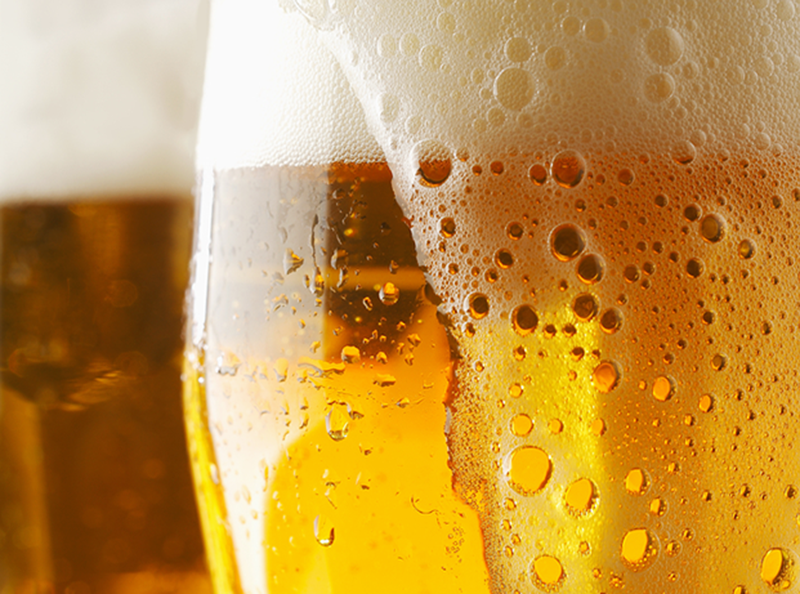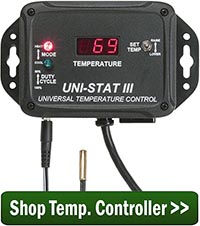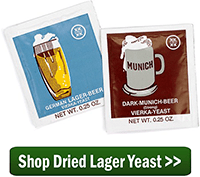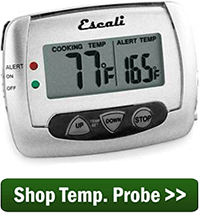 Lagers differ from ales in that they are fermented at a much cooler temperature. Simple right? But the exact procedures and temperature schedule for fermenting lager beer may vary. Below are some general guidelines for fermenting lager beer at home.
Lagers differ from ales in that they are fermented at a much cooler temperature. Simple right? But the exact procedures and temperature schedule for fermenting lager beer may vary. Below are some general guidelines for fermenting lager beer at home.
While ales typically ferment at room temperature (65-75˚F) all the way through the fermentation, a lager’s fermentation schedule is completely different. Lagers ferment at about 45-55˚F, and then go through an extended lagering phase at temperatures 10-15°F below the primary fermentation temperature.
If you’re brewing lager beer without a fridge, this usually means you’re brewing lagers in the winter, placing the fermenter in a cool basement, possibly rigging up a swamp cooler to help keep the fermenter in the desired temperature range. Alternatively, a spare refrigerator or chest freezer can be made into a fermentation chamber with the simple addition of a temperature controller. This allows the homebrewer to control the lager fermentation temperature to within a degree of the desired target, and to brew lagers year-round.
 Many of you want to know how long it take s to brew a lager beer. The typical lager fermentation temperature schedule looks something like this:
Many of you want to know how long it take s to brew a lager beer. The typical lager fermentation temperature schedule looks something like this:
- Primary fermentation – About 1-2 weeks at 45-55˚F. The exact time will vary on a number of factors, including the gravity of the beer, fermentation temperature, and the health of the yeast. It’s up to the brewer to judge when this period is complete, using either visual cues, gravity samples, or plain sixth sense to decide when to move on to the next step. When in doubt, follow guidelines as stated by a trusted homebrew beer recipe.
- Diacetyl rest (optional) – If you are fermenting at a warmer temperature, using a yeast strain known for diacetyl production, or if diacetyl is detected, a diacetyl rest can help the yeast “clean up” any buttery off-flavors due to diacetyl in the beer. Once fermentation noticeably slows down, simply allow the fermentation temperature to rise 10-15˚F and hold for 1-2 days.
- Lagering – The lagering phase is sometimes called cold maturation. This period, which can last four weeks or longer, helps with flavor development and with clearing the beer.
After the lagering period, bottle or keg as you would normally. If bottling, store the bottles at room temperature until ready to drink. Occasionally, the cold phase can inhibit yeast from creating carbonation in the bottle. If this is the case, you can open each bottle, add a few grains of dry lager yeast, and recap with new, sanitized caps. When in doubt, just go with your standard bottling procedure and be patient.
Here are some additional tips if you’re just starting out with brewing lager beer :
- Choose a yeast strain depending on the style of lager beer you’re brewing. For example, I’m brewing a German schwarzbier, so I’ll be using Bavarian lager yeast. Of course, there aren’t any rules that say you can’t use a Czech strain in a German beer, or a German strain in an American beer. As you brew more and more lagers, you’ll get a better sense of how individual yeast strains perform.
- Pitch plenty of yeast. As a rule of thumb, a lager fermentation requires about twice as much yeast as an ale of the same gravity. This is to help them plow through the rigorous lager temperature schedule more solidly. Use a yeast pitching calculator to figure out how much yeast to buy and whether to make a yeast starter.
- Determine your fermentation temperature. If you can get specific when brewing lager beer. You can do this by using a temperature controlled fermentation temperature chamber, that’s great. Choose your temperature based on yeast producers recommendations and the experience of others. Aim in the middle of the range if you’re unsure.
 Do a diacetyl rest. Just to be safe, I recommend a diacetyl rest. Allow temperature to rise at the end of primary fermentation. With a fermentation chamber, this can be easily done be increasing the temperature about 10- 15˚F for a two-day diacetyl rest. Then drop the temperature for the lagering phase. I know it’s one more step in the lager fermentation temperature schedule, but it’s well worth it.
Do a diacetyl rest. Just to be safe, I recommend a diacetyl rest. Allow temperature to rise at the end of primary fermentation. With a fermentation chamber, this can be easily done be increasing the temperature about 10- 15˚F for a two-day diacetyl rest. Then drop the temperature for the lagering phase. I know it’s one more step in the lager fermentation temperature schedule, but it’s well worth it.
- Be patient. Brewing lager beer takes quite a bit longer than brewing an ale, but it’s worth the wait. Use the following temperature schedule and timelines for the final lagering phase (depending on temperature): 3 – 4 weeks at 45°F, 5 – 6 weeks at 40°F, or 7 – 8 weeks at 35°F. Higher gravity lagers will need a longer lagering phase to fully mature.
- A note on pitching temperature: Some brewers recommend that you pitch yeast at the primary fermentation temperature, some say pitch warm then bring the temperature down, the idea being that this will help kick off fermentation. Do what works for you.
 This is the basics of brewing lager beer at home –how to approach a lager fermentation temperature schedule, timeline, diacetyl rest, etc. Realize that there are many variations on this, but there is enough information here to produce an excellent lager beer.
This is the basics of brewing lager beer at home –how to approach a lager fermentation temperature schedule, timeline, diacetyl rest, etc. Realize that there are many variations on this, but there is enough information here to produce an excellent lager beer.
If you’re used to brewing ales, maybe it’s time to try a lager. Here are 3 Homebrew Lager Recipes you can try.
—–
David Ackley is a beer writer, homebrewer, and self-described “craft beer crusader.” He holds a General Certificate in Brewing from the Institute of Brewing and Distilling and is founder of the Local Beer Blog.
